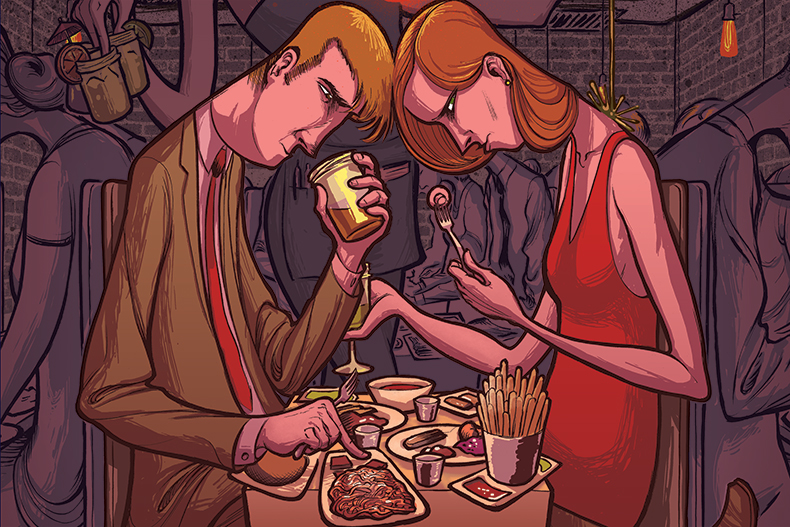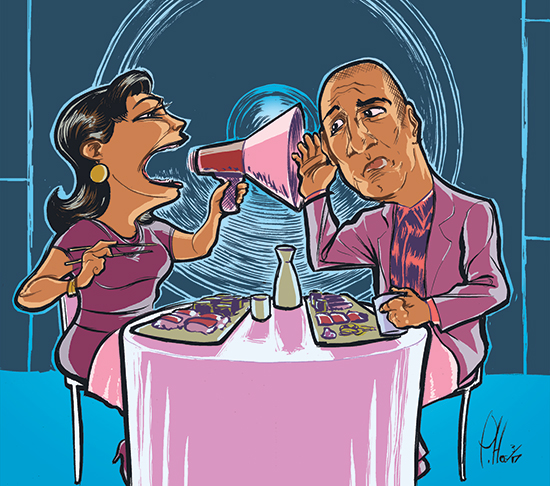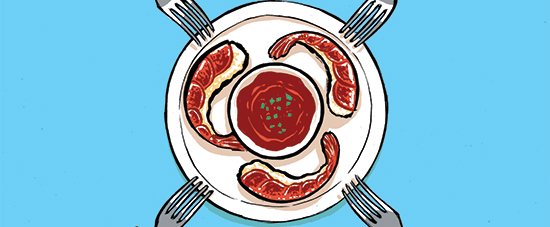Guest Rant
May 19, 2017
My friend David Hagedorn is a food expert. He talks about it, writes about it, cooks it, even eats it. He was a pioneer in the city, the chef-owner of Trumpets, a Nineties restaurant and nightclub near Dupont Circle. Now he writes.
He is co-author of several books, one of which is the Rasika cookbook that will be published later this year; and he writes for Bethesda Magazine and for Arlington Magazine in which this now appears:
Dear Restaurants: These Things Are Turnoffs
Our food critic, David Hagedorn, indulges in a bit of a rant.

As a restaurant critic, it’s my job to write about the total dining experience, not just the food. A lot of factors play into a customer’s overall impression of a place, including the décor, libations and, most importantly, service. In the end, it really comes down to one question: Would you go back? For restaurateurs who want to ensure that the answer to that question is always yes, here is some food for thought.
The Pregame
Service doesn’t start at the door. It begins the moment a diner calls a restaurant or visits the website. The site, by the way, should be user-friendly with the address, phone number, hours of operation and social media information on the home page. The menu should be easy to access and always include prices.
A no-reservation policy is, in my opinion, bad service.
When the person who answers the phone asks if he can put the caller on hold, he should give the caller time to say “OK” before pushing the hold button.
Valet service (if it is offered) is usually subcontracted, but that isn’t a pass for restaurant management to ignore what’s happening at the curb. The valets should be providing the same level of respectful service as the staff inside. And wouldn’t it be great if restaurants could figure out a way to put the valet charge on the bill so diners don’t have to take out their wallets before they even walk in the door?
Being a host is one of the hardest jobs in a restaurant. These front-line workers are usually paid very little and yet they are expected to placate unhappy patrons with calmness and élan. The host should not be left there untrained, alone and unempowered to fix problems that may arise.
The Ambience
Passing off inexpensive construction as hipster minimalist design may save money, but it furnishes discomfort and is therefore a disservice. I am tempted to create a keyboard shortcut—Control+Alt+Yawn—for the following scheme, which sadly applies to the majority of today’s new eateries: “an open, subway-tiled kitchen, concrete floors, exposed ductwork, Edison bulbs dangling from the ceiling, wooden benches and chairs as comfortable as buckboard.” Bunker décor is not awesome.

While I’m at it, here are some other design flaws that plague all too many establishments:
Lack of soundproofing. When noise—laughably rebranded as vibe or buzz—freely bounces off multiple hard surfaces, it makes conversation next to impossible.
Six-seater booths. This configuration often requires diners who are seated against the wall to take their plates (which may be oven-hot) from the hands of a server who can’t reach them. Which increases the risk that a part of said dish will land on the head of the person in the middle. I say, “Death to six-top booths!”
Form over function. Silverware that sinks into the middle of a wide, shallow serving dish and into a pool of sauce when I try to rest it against the rim? Not great. The same goes for heavy-handled flatware that falls to the floor (or onto me, which has happened plenty) when plates are cleared.
Skimping on drink lists. Why should four people have to share one cocktail menu? Print more.
Oversize menus. Sure, they’re dramatic, but when they obscure my ability to converse with the guest across the table, or are too awkward to put down anywhere (either before or after we’ve looked at them), the
The Booze
Cocktail programs have greatly improved in the last five years, but still I find that many concoctions are too sweet or unbalanced, and they often contain at least one ingredient I’ve never heard of or don’t want in my drink. (Falernum, shrub, verjus rouge or Cardamaro, anyone?)
I usually test the bar by ordering a Hendrick’s Gibson and asking if they have good cocktail onions—not the nasty little ones from Sysco that have been festering in the same jar for five years. If there are no cocktail onions (immediate deduction), my Gibson becomes a martini with an olive.
So here’s a question: If chefs are pickling everything else under the sun—as the current culinary trend seems to be—why not cocktail onions? Or at least keep a small jar of a good brand on hand. (I recommend mixologist Todd Thrasher’s, which are available at www.societyfair.net.) In the same vein, chuck those chemical-tasting maraschino cherries and invest in some tasty Luxardo cherries instead. Today’s drinkers are sophisticated. Rise to the occasion.
Small Plates, Big Problems

There are perhaps no words more terrifying to today’s diners than these: “We are a small-plates restaurant and our food is meant for sharing.” (As my husband likes to say, “If they’re small, you can’t share them!”)
Next, we are forewarned that the food will come out when it’s ready. Which means that if we don’t want to be in and out in 20 minutes, we have to keep at least one (possibly oversize) menu on the table or under one of our chairs so that we can set our own pace and order course by course. That’s not service; it’s the opposite of service.
Compounding this scenario, a server will invariably show up with our next course in hand, find the table filled to capacity, and look to us to do the rearranging to make room for our garlic shrimp and beef skewers. These will show up with three skewers to a plate, even though the order is meant to be shared by four people.
And if we are supposed to be sharing all this food, why are we only given bread-and-butter plates to hold it all?
The Service Game
By and large, I tend to receive excellent service in my dining adventures around the DMV, but there are annoyances, all of which could be fixed by better management. Allow me to catalog some of the misdemeanors most commonly committed by waitstaff:
Introducing themselves by name and telling me “I’ll be your server today.” I’m aware of their function. If I need something, I’ll catch their eye and politely say, “Excuse me.”
Asking if I’ve dined there before. If I have and they don’t recognize me, they are confirming that I’m forgettable. Fellow restaurant-goers, the answer to this question is always yes! Because if we say no, then we are about to get…
The Spiel. And The Spiel is to be avoided at all costs. We know how to read, right? If the menu is so complicated that it needs to be explained or translated, the owner or chef needs to rewrite it.
Validating or complimenting my order. I know what I ordered is a good choice. I just made it.
Auctioning off entrées tableside. To determine who ordered what. Servers need to learn guest position numbers and use them.
Using the royal We. As in, “How are we enjoying our meal?” Because one day I’m going to respond, “I’m enjoying my meal just fine. How are you enjoying yours?”
Accidentally pouring flat water into my sparkling water. Restaurateurs, here’s an idea: Use a different glass for sparkling water. Problem solved.
Leaving empty cocktail glasses on the table through dinner. Honestly, they just take up space. (Even more so if they are competing for real estate with 12 awkwardly overlapping small plates and an oversize menu or two.)
Throwing the kitchen under the bus. If the food is taking too long or if the order is wrong, don’t play the blame game. Get a manager involved.
Asking, “Are you still working on that?” If you are looking for a green light to clear dishes, the correct etiquette is to wait until everyone at the table has finished, then gesture toward my plate, look at me, and ask, “May I?”
Stacking plates when clearing the table. Just don’t. This isn’t a mess hall.
Bringing containers to the table for me to pack up my own leftovers. When did this bit of service become the diner’s responsibility?
Turning on the charm right before the bill comes. This, after being inattentive or less than pleasant all the way through the meal? I mean, c’mon.
The Devil’s in the Details
Little stuff really does matter. Even if the food is terrific, a lack of regard for the small things can kill a dining experience. Among my biggest pet peeves:
Fingerprints all over the front door. This is the diner’s very first impression of a place.
Cloudy water in flower vases. Especially in a giant arrangement at the host stand (a clear signal that other things might be off).
Brown-edged lemon or lime wedge garnishes.
Tables that aren’t set with salt and pepper.
Sour-smelling beer coolers and mats. This odor is instantly recognizable and off-putting to diners.
Dust. On light fixtures, shelves or displayed beer and liquor bottles. Or anywhere else, for that matter.
Crumpled or smudged paper menus. These should be single-use items. Print more.
Poorly maintained bathrooms.Which brings me to…
Yes, the Bathrooms
Call me old-fashioned, but I long for the days when I could squeeze soap into my palm, turn a faucet on, wash my hands as long as I pleased, turn the water off and dry my hands on an actual piece of cloth.
Nowadays I find myself performing a Marcel Marceau mime routine in every automated restroom, waving my upturned palm under the soap dispenser until it finally relents (or not)—at which point I have already given up and moved my hands to the faucet, doing the same hand dance for water that may or may not come.
Then I get to wave hello at the towel dispenser until it releases one measly square of paper that is insufficient for the task at hand. After a second (and usually fruitless) waving session, I give up and dry my hands on my pants, only to hear the dispenser click as I’m walking out the door, priming itself for its next victim. I’m pretty sure it’s laughing at me, too
Other Things I Could Do Without
In no particular order: dish-towel napkins (although I’d take them over polyester napkins), filament bulbs, Mason jars, mussels, burrata (there’s a lot of badly made burrata out there), branzino, beet salad, pickled everything, menus that play it fast and loose with food terms (not everything sliced thin is carpaccio; not everything cooked and chopped up is rillettes; not everything raw and chopped up is tartare), Brussels sprouts (especially deep-fried ones that are burnt or drenched in anything sweet, like maple syrup or honey), octopus, badly shucked oysters and finally…(deep breath) overwrought desserts that are rife with powders, gels, foams, drizzles and shredded pieces of sponge cake.
Who’s Doing It Right?
As a man who dines out four times or more per week, it’s hard to recall every detail and every transgression in every place. But if asked the fundamental question, Would you go back? I would say yes to these restaurants, all of which deserve shout-outs for getting the service angle right on my most recent visits (in no particular order): Ambar, SER, Requin, The Liberty Tavern, William Jeffrey’s Tavern, Rus-Uz Restaurant, Social Oyster Bar, Yona and Live Oak.
David Hagedorn is the food critic for Arlington Magazine and Bethesda Magazine. He feels 10 pounds lighter having gotten this off his chest.
Couldn’t agree more, well said!
Well said
Should be part of every restaurant’s training manual
Mark this guy sounds like you. I like me.
Sent from my iPhone
>
BRAVO!
I second the training manual! I love your blog!